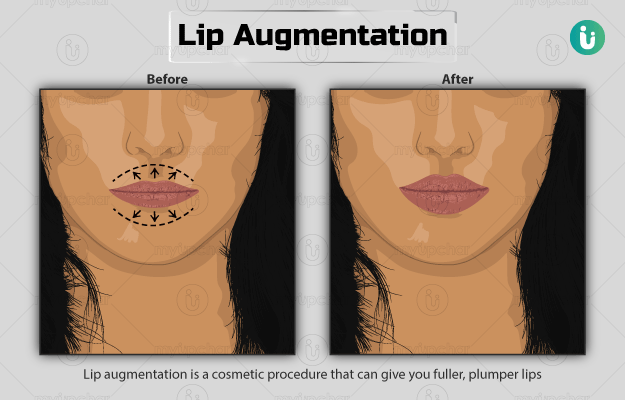Summary
Lip augmentation is a cosmetic procedure that is done to give a fuller appearance to lips and remove wrinkles around the mouth. The surgery is performed under local anaesthesia with or without a sedative.
There are several procedures that can be used to enhance lips, such a lip lift, dermal graft, lip implant and vermillion advancement. The surgeon may perform one or multiple procedures simultaneously, depending on your aesthetic goals.
The surgery results are usually semi-permanent to permanent. You may require a few weeks to months for a complete recovery and desired result; however, you will able to resume work within one to three days of surgery.
- What is lip augmentation?
- Why is lip augmentation recommended?
- Who can and cannot get lip augmentation?
- What preparations are needed before lip augmentation?
- How is lip augmentation done?
- How to care for yourself after lip augmentation?
- What are the possible complications/risks of lip augmentation?
- When to follow up with your doctor after a lip augmentation?
What is lip augmentation?
Lip augmentation is a cosmetic procedure that is done to reshape lips and increase lip size to give them a plump look. The procedure also helps smoothen fine wrinkles around your mouth.
The surface of the lips can be divided into the following parts: cutaneous lip, vermillion and oral mucosa. The cutaneous lip is the hairy skin present above the upper lip and below the lower lip. The vermillion forms the red portion of the lip extending up to the oral mucosa that forms the inner part of your oral cavity. Commissure refers to the point on either side of the mouth where the upper lip meets the lower lips. The border of vermillion is the edge of pale skin that separates the hairy part of the lip from the vermillion. The part of the vermillion border that is present on the upper lip is known as the Cupid’s bow because it looks like an archer’s bow.
Ageing can cause various changes in and around the lips, such as stretching of the cutaneous part, inversion of the vermillion and flattening the appearance of lips. Some individuals have naturally thin lips and different/abnormal shapes of the lips since birth. If you are unhappy with the shape of your lips and wish to change their appearance, a cosmetic surgeon may recommend you to undergo lip augmentation procedure.
Lip augmentation can be performed by various surgical procedures including dermal graft, lip implant, lip lift and vermillion advancement. The surgeon will choose the procedure based on your expectations and the period required for recovery. Multiple procedures may be done simultaneously to meet your aesthetic goal and provide you with the best and desired look.
Why is lip augmentation recommended?
You can consider this surgery if the current appearance of your lips makes you self-conscious or if you believe that fuller lips will balance your face shape.
Who can and cannot get lip augmentation?
Lip augmentation surgery may not be performed in individuals with the following conditions:
- Active infection in or around the lips
- Razor-thin lips (contraindication to lip implant)
In individuals with a thin vermillion and long lip-to-nose distance, surgeons perform a lip lift procedure before putting in a lip implant.
What preparations are needed before lip augmentation?
You will need to visit the surgeon a few days before a lip augmentation procedure for a preoperative assessment. During the assessment, your surgeon will ask you to share the following details:
- Your medical and surgical history
- List of medicines, such as herbs, vitamins and over-the-counter drugs, that you have taken previously or taking currently
He/she may also ask you to undergo certain blood and urine tests to ensure that you are medically fit for the surgery. Women may be asked to undergo a pregnancy test if they think they may be pregnant. Additionally, the surgeon will provide you with some of the following instructions to prepare for the surgery:
- Stop the use of blood-thinning medicines, such as warfarin, apixaban, one to two weeks before the surgery.
- Refrain from smoking as it may otherwise increase your risk of complications and delay healing.
- If you have a history of shingles/zoster, then your surgeon will prescribe an antiviral medicine to you. You must start taking the medicine from the day before the surgery.
- In case you have a cold, fever or flu on the days leading to the surgery, make sure to inform the doctor about it. In such a case, he/she might postpone or cancel the surgery.
- Wear loose-fitting clothes for the surgery.
- Make sure to take a shower and remove body piercings, make-up and nail polish before your arrival for the surgery at the hospital.
- A friend, family member or a responsible adult should be asked to drive you home after discharge from the hospital.
The surgeon will explain the procedure to you and tell you about the risks associated with the surgery. You will be asked to sign a consent formIf you agree to undergo the procedure.
How is lip augmentation done?
After you arrive at the hospital, the hospital staff will ask you to change into a hospital gown. Thereafter, you may be moved to the surgery room, where the surgeon or a nurse will insert an intravenous line in your arm to supply essential medicines and fluids during the surgery. The procedure is usually performed with local anaesthesia. It will numb your lip and the area surrounding it so that you do not feel any pain during the procedure. In addition, the surgeon will give you a sedative to make you feel sleepy. The various surgical procedures that may be performed during a lip augmentation surgery are as follows:
- Dermal graft: This is a permanent procedure in which the surgeon will remove a thin strip of fat and tissue from your thigh or other body parts, and surgically insert it into your lips to give them the desired shape.
- Lip implant: The surgeon will inset implants made of natural or synthetic materials (biodegradable) into your lips through small cuts in the corner of your lips.
- Vermillion advancement: The surgeon will introduce a cut along the vermillion border and removes a strip of skin from outside the border. He/she will draw the vermillion outwards to achieve the desired round shape.
- Lip lift: There are three subtypes of lip lift procedure:
- Lip corner lift: This procedure is performed to lift the lips that are drooping at the corners. The surgeon will remove a tiny triangular patch of skin from the upper outer edges of your lip.
- Direct lip lift: The skin from just above the Cupid’s bow is removed, and the upper vermillion is rolled outwards to decrease the nose-to-lip distance and increase the height of the upper vermillion.
- Indirect lip lift: This procedure is similar to direct lip lift; however, the cut is made in such a manner that it gets hidden in the base of the nose. The direct and indirect lip-lift procedures increase the visibility of the front teeth for an aesthetically improved appearance.
You will be able to go home on the same day of the surgery.
How to care for yourself after lip augmentation?
You may have some swelling in and around your lips for a while after the surgery. It usually subsides within two weeks. Your surgeon will provide some instructions to care for the enhanced lip at home, such as:
- Avoid strenuous physical activities for a few days after the surgery.
- Drink plenty of non-alcoholic fluids and eat soft foods to minimise discomfort while chewing.
Although you may require a few weeks or months to recover from the surgery, you will be able to continue your daily activities and work within one or three days of surgery.
The surgical procedures usually have a semi-permanent to permanent effect on lips. Lip augmentation will also remove fine wrinkles form around your lips and give you larger or fuller lips with relatively few complications.
When to see the doctor?
Immediately contact your surgeon if you experience any of the following symptoms after discharge from the hospital:
What are the possible complications/risks of lip augmentation?
The potential complications/risks associated with this cosmetic surgery are as follows:
- Infection
- Improperly placed lip implant
- Prolonged swelling in lips
- Dissatisfaction with the results of the surgery
- A need for revision surgery or removal of the implant
When to follow up with your doctor after a lip augmentation?
The surgeon will provide you with a schedule for follow-up appointments to monitor the healing progress of the surgical area.
Disclaimer: The above information is provided purely from an educational point of view and is in no way a substitute for medical advice by a qualified doctor.
Find Plastic, cosmetic and reconstructive surgeon in cities
- Plastic, cosmetic and reconstructive surgeon in Gwalior
- Plastic, cosmetic and reconstructive surgeon in Chennai
- Plastic, cosmetic and reconstructive surgeon in Gorakhpur
- Plastic, cosmetic and reconstructive surgeon in Raipur
- Plastic, cosmetic and reconstructive surgeon in Mumbai
- Plastic, cosmetic and reconstructive surgeon in Jaipur
Surgery Cost In Your City
Doctors for Lip Augmentation

Dr. Raajshri Gupta
Plastic, Cosmetic & Reconstructive Surgery
8 Years of Experience

Dr. debraj shome
Plastic, Cosmetic & Reconstructive Surgery
9 Years of Experience

Dr. Chandan Sahu
Plastic, Cosmetic & Reconstructive Surgery
10 Years of Experience

Dr. Navdeep
Plastic, Cosmetic & Reconstructive Surgery
11 Years of Experience
References
- The American Society for Aesthetic Plastic Surgery [Internet]. New York. US; Lip Augmentation
- National Genome Research Institute [Internet]. National Institute of Health. US Department of Health and Human Services; Anatomy of the Lips, Mouth, and Oral Region
- Brody-Camp S, Raggio BS. Lip Implants. [Updated 2020 Jun 18]. In: StatPearls [Internet]. Treasure Island (FL): StatPearls Publishing; 2020 Jan
- Piccinin MA, Zito PM. Anatomy, Head and Neck, Lips. [Updated 2020 Aug 10]. In: StatPearls [Internet]. Treasure Island (FL): StatPearls Publishing; 2020 Jan
- British Association of Aesthetic Plastic Surgeons [Internet]. London. UK; Lip enhancement
- American Board of Cosmetic Surgery [Internet]. Indiana. US; Lip enhancement
- National Health Service [Internet]. UK; Before surgery
- Johns Hopkins Medicine [Internet]. The Johns Hopkins University, The Johns Hopkins Hospital, and Johns Hopkins Health System; Lip Augmentation
- UT Southwestern Medical Center [Internet]. Texas. US; Lip Augmentation and Enhancement
- UCSF Facial Plastic Surgery [Internet]. University of California San Francisco. California. US; Lip Enhancement
- Browner Bruce, et al. Skeletal trauma: basic science, management, and reconstruction. 5th ed. Philadelphia, PA: Elsevier Saunders; 2015. Chapter 22, Surgical site infection prevention.
- Townsend Courtney, Beauchamp R. Daniel, Evers B. Mark, Mattox Kenneth. Sabiston Textbook of Surgery. 20th ed. Philadelphia, PA: Elsevier; 2017
- Cameron John L, Cameron Andrew M. Current surgical therapy. 12th ed. Philadelphia, PA: Elsevier; 2017















